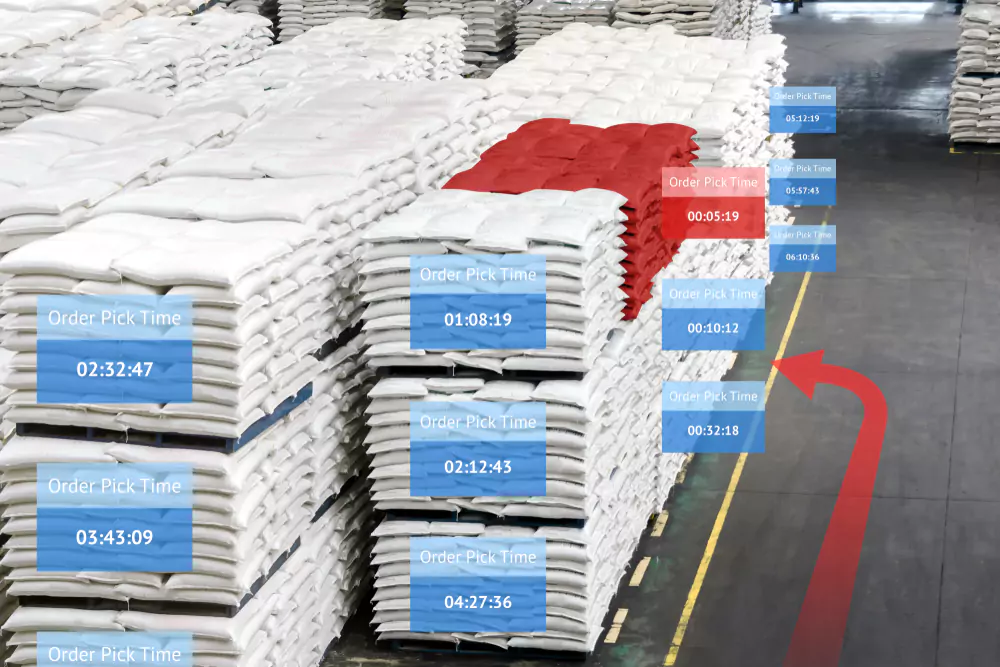In the world of supply chain businesses, time is money. The faster you can get products out the door and onto store shelves, the more successful your company will be. That’s why wave picking is becoming an increasingly popular choice for warehouse operations. But what is wave picking, and how can it improve your warehouse operations? In this blog post, we will answer those questions and more.
What is Wave Picking?
Wave picking is a type of order fulfillment strategy in which orders are grouped together into “waves” based on factors such as due date, order size, and product availability. These waves are then picked simultaneously instead of individually. This allows warehouse staff to pick multiple orders at once and move through the warehouse quickly.
This type of picking is a form of short-interval scheduling (SIS). Short-interval scheduling is designed to optimize the fulfillment process by assigning tasks in a way that best suits the needs of the warehouse. It helps warehouses reduce labor costs and improve efficiency by reducing the time it takes to pick and process orders.
Compared to a popular picking methodology like zone picking, wave picking allows warehouses to process orders faster and with fewer errors. With wave picking, staff can easily move between different zones and pick multiple orders at once. This is especially helpful for warehouses that have high-volume orders or have a lot of different SKUs.
How Does Wave Picking Work?
Wave picking works by utilizing a Warehouse Management System (WMS) to separate orders into different pick waves. The WMS then calculates the most efficient route for warehouse staff to take while picking products, ensuring they are able to get each order completed quickly and accurately. Once all orders in a wave have been picked, the warehouse staff can then move on to the next wave of orders.
Pre-Wave Picking
Before wave picking can begin, orders must be divided into “pre-waves”. This is the process of grouping together similar orders based on factors such as due date, order size, item availability, and more. The pre-wave process helps to ensure that pickers have the necessary items for each order and makes it easier for them to move through the warehouse quickly.
Performing Wave Picking
Once orders have been divided into pre-waves, the wave picking process can begin. Pickers will move through the warehouse and pick all items in each wave before moving on to the next one. This allows them to fulfill multiple orders at once and complete more orders in a shorter amount of time.
Post-Wave Picking
Once the wave picking process is complete, post-wave picking should be performed. This involves double-checking all orders to make sure that everything has been picked correctly as well as packaging items for shipment. This helps to ensure that customers receive their orders quickly and without any errors or issues.
Designing Your Wave Groupings
When setting up wave picking for your warehouse, it’s important for warehouse managers to carefully consider the type of waves you create. This will depend on factors such as item availability, order size, and due date. For example, if you have a large number of orders that need to be shipped out quickly, it may make sense to group them into one large wave. On the other hand, if you have orders of varying sizes and due dates, it may be more efficient to create multiple smaller waves.
Those are just a couple of considerations when designing your wave groupings. Here are more ways to group your waves:
Shipping Schedule
Group orders based on their shipping schedule. By designing waves based on their transportation schedules, you can ensure that orders are shipped out on time.
Shipment Number
Group orders by shipment number. This helps to ensure that each wave contains the correct items and helps to prevent accidental picking errors.
Product Location or Similarity
Group orders based on product similarity or being in the same location. This helps to streamline the picking process by ensuring that pickers are only visiting one area of the warehouse for each wave.
By Carrier
If you’re shipping orders via multiple carriers, create waves based on the carrier. This helps to ensure that each order is shipped with the right carrier and reduces the risk of delays or mistakes.
By Warehouse Priority
Design waves based on your warehouse’s priority. This way, you can ensure that orders with higher priority are picked and shipped out faster.
By Labor Schedules
Consider your labor schedules when creating waves. By grouping orders into waves that can be completed by the same staff member or within a certain shift, you can help to reduce labor costs and increase efficiency. This also reduces the risk of mistakes during an order picking handoff.
Replenishment Picking
In addition to wave picking, you may also want to consider adding replenishment picking. This involves stocking shelves with items that have low levels or have been running low throughout the day. This can help to reduce picking times and ensure that shelves are always stocked with the necessary items.
Explain Dynamic Wave Picking vs. Fixed Wave Picking
Dynamic wave picking is a type of order fulfillment technique where items are picked and packed as soon as they are completed. This helps to ensure orders are picked, packed, and shipped out quickly and efficiently. With dynamic wave picking, each order will be sent to the packing area immediately after it has been fulfilled.
Fixed wave picking, on the other hand, involves grouping orders together and picking all items in a single wave. In this type of fulfillment process, orders will be held until all items in the wave have been picked. Once everything in the wave is complete, it can then be sent to packing or shipping. This helps to reduce labor costs by allowing pickers to fulfill multiple orders at once. However, it can also cause delays in fulfillment if orders have different due dates or don’t require the same items.
Advantages of Warehouse Wave Picking
Wave picking offers several advantages over traditional order picking methods. Let’s discuss a few of the most important here:
- Achieving on-time shipping: Wave picking allows orders to be planned in advance to meet the cut-off time for shipping. This helps to ensure that orders arrive on time and without any errors. This helps ensure that customers receive their orders on time and can improve customer satisfaction.
- Higher productivity: By grouping similar orders together into a wave, you can increase the number of orders that can be fulfilled at once. This helps reduce repeated trips, resulting in higher productivity levels overall.
- Improved Efficiency: Wave picking helps to reduce the amount of time that it takes to pick orders by grouping them together into pre-defined waves. This reduces aisle congestion and minimizes the chances that equipment like pallet jacks or forklifts will be blocking pickers’ access to items.
- Better for fresh goods: Wave picking is especially beneficial for food and other items that are prone to spoilage or have a short shelf life. By grouping orders together, these items can be fulfilled and shipped out quickly, which reduces the chance that orders will spoil or expire.
- Reduced Errors: This picking method also helps to reduce errors as each wave contains similar items which makes it easier for pickers to select the correct items quickly. By using multi-tote carts and one worker per wave, the chances of errors are further reduced.
- Cost Savings: Wave picking can lead to cost savings as it requires fewer pickers and reduces the amount of time spent picking orders. This allows you to optimize your resources and maximize profits.
What Are the Disadvantages of Wave Picking?
Despite the benefits of wave picking, some potential drawbacks should be considered. These include:
- Increased Setup Time: Picking in waves requires more setup time as each wave must be created and configured. If this were attempted manually, this could lead to delays in order processing and a consequent loss of customer satisfaction. However, this can be minimized by using a WMS with an automated wave-picking system.
- Limited Flexibility: Wave picking can be inflexible as orders are grouped into pre-defined waves, making it difficult to adjust for unexpected changes. This means, if an order needs to be picked quickly or if a new order needs to be added, it may not be possible to make the necessary changes. Therefore, you must pay closer attention to the shipment end-loading time to ensure that all orders are fulfilled on time.
- Complexity: Wave picking can be a complex process as it requires the use of several different components. This includes a WMS, barcode scanning equipment, and multi-tote carts. If these components are not properly integrated, this could lead to delays or errors in order processing.
Tips to Optimize a Wave Picking Strategy
We’ve discussed the advantages and disadvantages of wave picking. Now let’s look at how you can optimize your strategy to maximize efficiency and minimize errors.
- Choose a Leading WMS: A WMS is essential for wave picking as it helps to plan and schedule waves, assign tasks to personnel, and ensure that orders are processed on time.
- Establish a Timeline for Delivery: Establishing a timeline for delivery is key to ensuring that orders are fulfilled on time. This includes determining the cut-off times, establishing a plan for picking orders, and scheduling delivery times.
- Choose the Right Equipment: Choosing the right equipment can also help to improve efficiency and reduce errors. This includes investing in barcode scanning equipment, multi-tote carts, and other items that can help streamline the picking process.
- Train Personnel: Training personnel is essential for optimizing wave picking. This includes teaching them about the different components of the system and how to use them properly. It also involves teaching them about the importance of accuracy and speed when selecting items.
- Review Performance Regularly: Lastly, it is important to review the performance of your wave picking system regularly. This includes assessing the accuracy and speed of order fulfillment, as well as any potential issues or bottlenecks. This can help to identify areas that need improvement and adjust the system accordingly.
By following these tips, you can create an efficient wave picking system that can help to reduce time and costs associated with fulfillment.
Batch Processing vs. Wave Picking
Batch processing and picking in waves are two different strategies that can be used to pick orders.
What is Batch Picking?
Batch picking or batch processing is a picking strategy where orders are grouped into batches and assigned to pickers. This allows multiple orders to be picked at once, resulting in increased efficiency and lower costs. This is a relatively simple method, as it does not require the use of complex equipment or resources. However, it is not always as efficient as a wave pick and can lead to delays in order processing.
Wave processing, on the other hand, involves grouping orders into smaller waves and assigning them to pickers. This allows for more efficient fulfillment as multiple orders can be processed at once. However, it requires a greater amount of setup time and is prone to errors if the system is not properly optimized.
Overall, a batch picking or wave picking strategy both have their advantages and disadvantages. For businesses looking to improve order fulfillment, it is important to consider which strategy is best suited for their needs. By doing so, they can ensure that orders are fulfilled quickly and accurately.
Wave Picking Conclusion
In conclusion, wave picking is an efficient and cost-effective method for order fulfillment. It allows businesses to reduce costs associated with labor, inventory storage, and order processing. However, it requires a greater level of setup and optimization to ensure accuracy and efficiency.
By following the tips listed above, businesses can optimize their wave picking system for maximum efficiency. Additionally, by investing in a leading WMS such as SphereWMS, businesses can ensure that their wave picking system is properly optimized and automated. This helps to reduce errors, improve accuracy, and streamline order fulfillment processes.
Ultimately, through proper optimization of their picking strategy, businesses can increase efficiency and save time and money. To learn more about how SphereWMS can help your business optimize your order picking, please contact us today.








